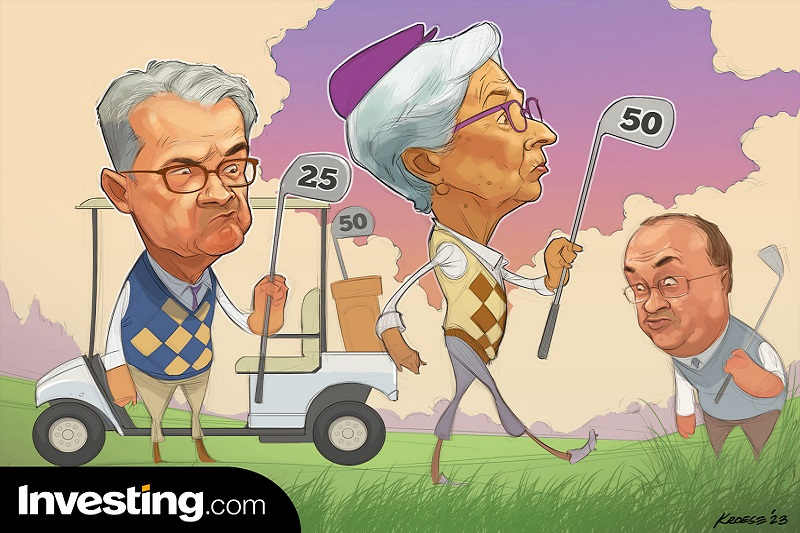Gold prices rebound after sliding below $4,000/oz amid safe-haven demand
By Geoffrey Smith
Investing.com -- A tense couple of weeks are in store for global financial markets.
Investors have spent recent days resigning themselves to the fact that interest rates in the U.S. and euro zone are going higher than appeared likely at the turn of the year. The hopes of a quick end to monetary tightening and an early ‘pivot’ to interest rate cuts by the end of the year now seem forlorn.
Short-term interest rate futures now reflect expectations of a peak Fed Funds rate of 5.5% and an ECB refinancing rate of 4%. That’s 0.75% and 1%, respectively, higher than at present. As for rate cuts – they won’t be seen before 2024.
With the world’s two leading central banks tightening financial conditions further, the headwinds for global markets – which have thrived since 2009 on historically cheap money - are likely to intensify, at least in the short term.
However, there are reasons to think that neither the ECB’s meeting in Frankfurt next Thursday, nor the Federal Reserve’s a week later, will be quite as hawkish as feared.
Firstly, Fed Chair Jerome Powell left himself a lot of wiggle room on Tuesday when he told the Senate Banking Committee that the Fed could revert to bigger rate hikes “if the totality of the data were to indicate that faster tightening is warranted.”
The loss of credibility that this would entail, only a couple of months after saying that a disinflationary trend had set in, means that a 25 basis point hike is still the most likely outcome when the Fed meets.
Secondly, the ECB will not like having to go first. It will – almost certainly – raise its key rate by 50 basis points, but the key variable – Lagarde’s guidance for the subsequent meeting in May – will be tempered by awareness that it rarely pays to appear more hawkish than the Fed.
At $1.06, the euro is still cheap against the dollar, and euro zone companies have a clear funding advantage over their U.S. counterparts as a result (a much-needed one, given how much higher energy and non-wage costs are in Europe than in the U.S.).
As such, Lagarde is unlikely to commit herself immediately to another 50 basis points hike in May.
After all, why would she? Inflation is falling (even if the core rate accelerated in February), and key leading indicators suggest it will fall further and faster from the second quarter, as this year’s prices start to get measured against the spike of a year ago. Producer price inflation, in particular, is slowing sharply, down to ‘only’ 15% in February from a peak of over 43% in September.
As Berenberg Bank chief economist Holger Schmieding argues, natural gas prices are “still the single most import driver of euro zone inflation,” and these hit their lowest since the summer of 2021 on Thursday, after a big LNG export terminal in the Gulf of Mexico got the regulatory all-clear to resume operations.
Dutch TTF futures, the reference price for northwest Europe, which looked as though they would settle into a range four or five times their historical average after the loss of cheap Russian gas, now trade at only twice that. While that’s still painful for energy-intensive industry in particular (see BASF’s capacity closures last month for details), it’s less likely to be the difference between life and death for other euro zone companies.
But while inflation is undoubtedly heading down, there is still real uncertainty over how far and how fast it will fall. Food prices in particular remain a worry, given the lagged effects on harvests from the disruption of the global fertilizer trade.
TS Lombard’s Konstantinos Venetis, in a preview of the Bank of England meeting that takes place a day after the Fed’s, makes the point that inflation never comes down in a straight line – something likely to frustrate both the hawks and the doves on the Monetary Policy Committee. Their counterparts in Washington and Frankfurt are likely to feel the same.
On the minds of all three central banks in the next fortnight will be the first signs of stress in the U.S. banking system. The collapse of Silvergate (NYSE:SI), an institution that focused on banking for the crypto sector, may be styled as particular to that isolated niche of the financial markets. But the problems of Silicon Valley Bank (NASDAQ:SIVB), sitting on billions of unrealized losses in loans to startups, are another thing entirely. After all, much of the U.S.’s financial system, wholesale and retail, has bet heavily on startups in one form or another over the last decade.
Before the last financial crisis in 2008, central banks kept raising rates well after systemic problems started to become apparent, making the subsequent crash worse than it might otherwise have been. Given the tendency for authorities to fight the last war rather than the one in front of them, the risk is that this generation of central bankers may lean the other way.
“We are getting closer to the point where the macro costs of going 'too strong for too long' on rate hikes start to outweigh the benefits,” Venetis warns. “As the tightening cycle enters a mature phase, this warrants a more nuanced approach to policy.”
